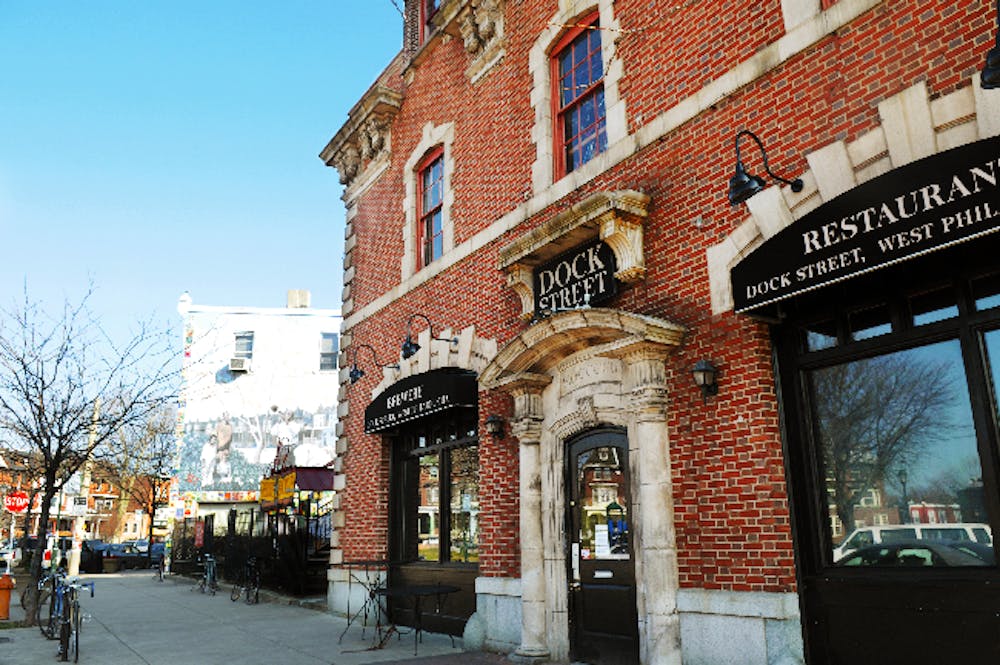Like any urban intersection, 50th St. and Baltimore Avenue is an amalgamation of different stores and walks of life. But for many who frequent the neighborhood that surrounds it, this intersection divides more than just the street. Here, Baltimore draws a physical line between two groups of people. 50th and Baltimore may be 10 blocks from campus, but studying it reveals a story of Philadelphian gentrification that stems from the actions and policies of our university.
The story of 50th and Baltimore begins with the creation of Penn Home Ownership Services in 1965. College Advisor Molly McGlone explained the significance of PHOS to 50th and Baltimore as she sat across from me in McClelland Dining Hall in the Quad. As a faculty member who lives on Penn’s campus, she said PHOS is a program that was created to attract Penn faculty to West Philadelphia.
“Penn is making it easier for anyone who works here to move out to West Philly,” she explained. Offering a loan of up to $7,500, PHOS has simplified the home–owning process for faculty and staff in West Philadelphia. The program began in the 1960s, after a decade of transition in the racial makeup of West Philly, in an effort to maintain a Penn community close to campus and alleviate long commutes for faculty members. It addressed the need to retain faculty members and their families who might have moved out to the suburbs by adding a financial incentive to owning homes in the neighborhood.
But anchoring Penn employees in West Philadelphia can take more than $7,500, especially in areas where homes can cost upwards of half a million dollars. There are other incentives as well. McGlone then mentions the Penn Alexander School, a Pre–K–8 school created by Penn. According to her, the chance to send your children to such a high–quality school makes living and working in West Philadelphia suddenly seem like a better idea.
50th and Baltimore is interesting then, she tells me, because it’s just a few blocks outside the Penn Alexander catchment. If your house lies in the catchment, your child can go to Penn Alexander, and the value of your house instantly goes up. Houses outside of the Penn Alexander zone are relatively less expensive, so poorer families tend to buy homes there. Even though 50th and Baltimore isn't a border of the catchment, Molly has still noticed a financial, and often racial, divide between the north and south side of Baltimore.
McGlone's husband Adam chimed in, “You cross the street from Satellite Café to Cedar Park, and there’s a clear difference.” The two visit 50th and Baltimore frequently. “On that side, there are no more hipsters.”
I decided to head out to the intersection to see this phenomenon myself. On a Sunday afternoon around 4:30 p.m., there were a handful of kids running around Cedar Park. The park lies on the southeast corner of the intersection of 50th and Catherine St., bounded on its south end by the oblique–running Baltimore Ave. It’s a small triangle of green contained between one commercial and one residential block of West Philadelphia; on that day, the park was filled with the sounds of children playing and mothers and sisters talking loudly, often shouting after the little ones. The women, some in their 20s, others significantly older, hovered on the periphery of the playground. All of the kids were black, except for one white toddler. An older white woman stood in a green sweatshirt a few feet away from him, smiling to herself as she watched the wobbling infant.
Across the street, there’s a collection of brightly–colored storefronts, sporting everything from a bike store to a brunch spot to a well–lit microbrewery, all of which scream gentrification. Outside, couples and friends sat on black metallic furniture, enjoying the food and each other’s company. The majority of these people appeared to be white yuppies in their 20s or 30s. Most of them are dressed in black and smoke cigarettes. All of them are on the south side of the intersection.
Firehouse Bicycles, located on 50th St., wasn’t always a bike shop. It used to be an actual firehouse building, one that had been abandoned and left without a productive use. A community group attempted to bring the firehouse back into use as a spot for small, local businesses to set up shop. When this endeavor failed, more upscale businesses moved in. Today, storefronts like Satellite Café and Firehouse Bicycles allow affluent crowds to eat brunch and peruse bike accessories as they please.
I walk my bike up to the colorful Satellite Café and a sign tells me that Firehouse Bicycles is located on the second floor. A bright red flight of stairs leads to a balcony and the adjacent bike shop.
Once inside the bike shop, I stand awkwardly in the front of the store for a few minutes before a young woman asks me if she can help me with anything. She’s young, with long, tangled hair and piercings. Out of curiosity, I ask how much a new lock costs. The standard package, she tells me, starts at $35 and the prices go up from there. I thank her and ask if I can just look around, mentally congratulating myself for purchasing my lock online for $16.
Near the front of the store, there is a room exclusively for repairing and maintaining bikes. A couple of grungy dudes in beanies stand around, laughing. Outside the room, a father and his son pace anxiously as they wait for their bike to be returned, hopefully in one piece. Occasionally one looks at the other, but neither has anything to say. For a minute, all you could hear is the sound of laughter from the repair room. When I grab my bicycle and turn to leave, no one tells me goodbye or to have a nice day.
Urban Studies Professor Eric Schneider explained the theory behind how 50th and Baltimore came to be as it is today. In the 1930s, homeowner loans associations would look at a map and physically cross out the poor neighborhoods that they believed wouldn’t qualify for a home loan. This process, which is illegal today, created a sort of self–fulfilling prophecy: the older, more run–down neighborhoods that required more capital in order to revitalize their housing stock became less likely to receive it. It also created an opportunity for wealthy white families who could afford loans to move in and improve on these neighborhoods.
This is how the process began, and gentrification is a fitting, if loaded, term for the transformations West Philadelphia has undergone. It’s the reason why 50th and Baltimore’s Dock Street Brewery is next to what was once an abandoned firehouse. It’s the reason why houses that fall within the Penn Alexander catchment are more expensive than those beyond it. It’s the reason why Baltimore Ave. got new streetlights installed, why bars and restaurants that cater to affluence were opened past 40th, and why buildings like the Penn Bookstore were built where there were once vacant parking lots.
Eric Miller, Editor–in–Chief of Magnet Magazine, studied journalism at Temple University in the 1960s and remembers the way race and geography collided on Penn's campus. “You know the McDonald’s on 40th and Walnut? Back then, that place used to be scary. No one really wanted to go past that spot.”
I nod, but wonder exactly who he’s thinking of when he says “no one.” Even without that knowledge, I recognize the context of his statement. Miller went to college at a time when the racial demographic in West Philadelphia was swinging from a white majority to an even split between whites and blacks. There are a lot of important considerations when talking about a neighborhood's changes, but it's fair to say that the area around McDonald's is no longer as dangerous as it once was. If crime is the primary issue, then things have improved.
“Students have benefited from the process of gentrification,” said Schneider. He believes it “makes the community more interesting and safer for Penn students.” Schneider cites dropping crime rates to show that homicidal hotspots are no longer adjacent to Penn’s campus. But not everyone has enjoyed Penn’s presence in the neighborhood. In recent years, widely–circulated bumper stickers have proclaimed: “THIS IS WEST PHILLY. ‘University City’ is a marketing scheme.” The stickers call attention to the fact that two Penn grads coined the name “University City” sometime in the 1950s to attract Penn faculty back to West Philadelphia. And when University City District installed flags on Baltimore light posts, posters went up that invited community members to steal the flags and appropriate them as their own.
The problem, then, isn’t limited to safety. It's figuring out how people of vastly different backgrounds can share a space. As long as Penn students are benefiting from living in the area, they should be concerned with its well–being. West Philadelphian harmony isn’t something that should be left up to housing loans and marketing campaigns, and Schneider agrees. “What is Penn besides an investment bank and a real estate development company? We have to pay attention to our neighbors in the community,” said Schneider. The divide of 50th and Baltimore is, in the end, a microcosm that illustrates the nature of Penn’s presence west of the Schuylkill. It’s not clear yet what can be done to make sure that Penn and West Philadelphia’s bumper sticker–applying and flag–stealing locals can coexist. It is clear, though, as Schneider points out, that “We’re anchored here and can serve a stabilizing purpose in the city.” We just need to keep trying to figure out how to go about realizing that purpose.
Frida Garza is a sophomore studying English. She's from El Paso, TX.







